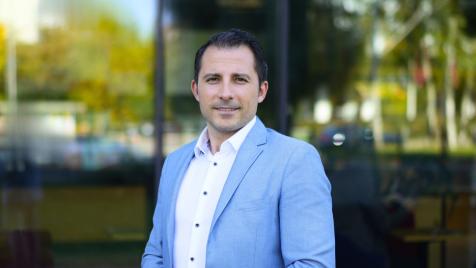From coal to hydrogen: The green course of Bobov Dol Thermal Power Plant
Biomass, solar energy, and natural gas complement the hydrogen vision of one of the largest employers in the Kyustendil region

All coal regions in Europe and around the world are looking for their path to decarbonization. Bulgaria is also trying to find good examples. The Bobov Dol Thermal Power Plant in the Kyustendil region is emerging as an example of active transformation, aiming not only to comply with environmental standards but also to ensure a socially just transition. Instead of waiting for a forced closure, the plant is taking major steps to diversify its energy mix and create new economic opportunities for the region.
To talk about the path to transformation, Elka Zareva, head of the Ecology Department at Bobov Dol TPP, and Galen Monev, representative of the Brown to Green platform, took part in the International Conference “Fair Transition in Kyustendil.”
The road to sustainability
Bobov Dol TPP has already taken real steps towards more sustainable energy production. Back in 2018, the plant changed its energy mix, which currently includes 80% coal and 20% alternative fuels – biomass and non-hazardous waste. The vision for a green future includes a number of specific projects that are already being implemented or are in the planning stage:
- Co-incineration of biomass and waste: Since 2018, the plant has been using 20% biomass and non-hazardous waste as an alternative to coal, reducing its carbon footprint and utilizing raw materials that would otherwise pollute the environment.
- Photovoltaic park: A 100 MWp solar park is already operating on the old sludge storage site, which does not affect fertile agricultural land. A battery farm for energy storage and grid balancing is to be built next to it.
- Natural gas as a bridge fuel: The power plant is to be connected to the nearby gas pipeline. Natural gas will be used both to fire the boilers and for future high-efficiency gas cogeneration capacities with a total capacity of 42.96 MW.
- Biogas plant: A plant for the production of high-energy biogas from biomass has been delivered to the power plant site, which will generate 6.9 MW of electricity and utilize the heat in technological processes.
- Hydrogen horizon: Long-term plans include the construction of a flexible combined cycle power plant (CCPP) with gas-hydrogen turbines and a steam turbine with a total capacity of up to 200 MW. The necessary green hydrogen will be produced on site through electrolysis powered by renewable sources.
- Battery storage: An additional 25 MWh battery farm will support grid balance in southwestern Bulgaria, compensating for fluctuations from RES and providing regulation services.
These projects demonstrate Bobov Dol TPP's commitment to modernization and reducing its dependence on coal, taking the initiative for change “from the inside out.”
A new beginning for the region
In the context of the European Green Deal and the phasing out of coal-fired power plants, the fate of Bobov Dol TPP and the thousands of jobs it supports is crucial for the Kyustendil region. As Elka Zareva, head of the Ecology Department at the headquarters, emphasises, a just transition should not be seen as an end, but as a new beginning.
According to Galen Monev from the Brown to Green platform, transition means socially responsible transformation, not the mechanical closure of power plants, which would lead to a social crisis.
A just transition does not mean shutting down a thermal power plant and saying, “That's it.” That is a recipe for social crisis, not progress," Monev said during the forum.
An example of an alternative approach is the Bobov Dol thermal power plant, which, according to him, is on the path to transformation through new technologies, alternative fuels, and investments in renewable sources.
The Bobov Dol thermal power plant is not only an energy facility but also a major economic driver, providing direct employment for about 1,000 people and supporting another 3,000 to 4,000 jobs in related activities such as mining and transportation.
Aware of this responsibility, the plant's management plans to create an industrial park on the site, which will be powered by clean energy from the new facilities. The aim is to attract small and medium-sized enterprises and create new jobs to compensate for any job losses in traditional activities.
Training and community involvement
The success of a just transition depends to a large extent on the preparation of the workforce for the new industries and the active involvement of the local community. Elka Zareva emphasizes that training must be closely linked to the specific needs of the future industries.
The creation of new production facilities must precede mass retraining in order to offer real prospects to those undergoing training. Despite the challenges, many young people work at the headquarters, which shows that the energy sector continues to attract specialists, especially when it offers modernization and development.
We cannot train people without knowing what we will use them for. First, we must create the new production facilities and then prepare specialists for them,“ said Zareva.
Galen Monev emphasizes the importance of a ”bottom-up" approach, in which local people, businesses, trade unions, and authorities themselves determine their path to a just transition. From May 1, 2025, the Brown to Green platform will begin concrete work in the Pernik and Kyustendil regions as part of a large-scale eight-year international project led by partners in Poland (Eastern Greater Poland). The project aims to achieve real decentralization of decision-making.
Local people, businesses, trade unions, and authorities will choose their own path to a just transition and formulate it in a strategy for the region," explained Monev.
This strategy will be developed over the next two years, with the experience gained in Bulgaria and Poland subsequently being used in North Macedonia and Greece.
Action now, not in 2038
Representatives of the Bobov Dol thermal power plant are unanimous that the transition should not be delayed. Action is needed now to ensure a smooth and successful transformation.
The power plant's package of green projects – including biomass, biogas, solar, natural gas, and future hydrogen—shows that a just transition can be environmentally, economically, and socially beneficial.
The key lies in a proactive approach, investment in new technologies, and the people who, with their skills and willingness to learn, will guide the region through this important process.
The most valuable thing we have is the ability to learn. Only with this will we successfully navigate this process," Zareva emphasized.
This article was prepared with the assistance of Bobov Dol Thermal Power Plant.
Translated with DeepL.

 Gloria Hristova
Gloria Hristova 


